 In this article, I am going to tell you about the best gym exercises for rugby players.
In this article, I am going to tell you about the best gym exercises for rugby players.
There are vast amounts of training programmes available on the internet, which means that it is easy to find a good training program and to educate yourself on proper weight training, however, this also means that it is easy to find yourself following a training plan that is not right for you.
In this article, I will not only tell you about the best exercises for rugby players, but also show you how to perform them properly and incorporate them into your routine.
1. Deadlift
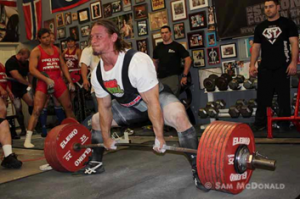 The deadlift (both conventional and sumo stance) is probably the most important exercise you can do – whether you train for rugby, or just want to be big and strong.
The deadlift (both conventional and sumo stance) is probably the most important exercise you can do – whether you train for rugby, or just want to be big and strong.
The reason that this exercise is so good is that it works the legs, grip and the whole of your back. Developing these parts of your body will allow you to physically dominate your opposition.
Conventional vs. Sumo Stance
Individuals that have very long arms and a short torso will find the conventional/narrow stance pull easier. Individuals with shorter arms and longer torsos will often find the sumo/wide stance easier.
Please see the photo above for an example of the sumo stance and the photo below for an example of the conventional/narrow stance.
The conventional stance will work your back more, and the sumo will target your hips and legs a lot more. I find that it is best to incorporate both into your training programme to get the full benefit of the movements.
Technique
 The deadlift is one of the simplest movements to perform.
The deadlift is one of the simplest movements to perform.
For the conventional pulling style, have your feet between a fist and shoulder width apart. Your grip should be wide enough so that if your arms were locked out they would not get in the way of your knees.
For the sumo deadlift, take a wide stance, turn your toes out slightly and grip the bar so that your arms are perpendicular to the floor.
From here both lifts are similar – take a deep breath and brace your abs, bring your head back and try to create a neutral spine whilst relaxing the shoulders. Imagine pulling the bar back into your body by driving your legs. Once your legs have straightened out, begin finishing the lift by extending your back and squeezing the glutes.
Quantity
Deadlifts should be done early on in a full body routine for rugby players. You should perform 1 to 5 reps for moderate volume (rarely venturing into the higher rep ranges). This allows you to build your strength, and keep your form tight.
When incorporating both stances, you should first perform the stance in which you are strongest and finish with your weaker puling style.
Here is an example:
1. Conventional Deadlift – Ramp up to 90% of 1RM for 5 singles
2. Sumo Deadlift – 3 heavy sets of 5 reps
2. Front Squats
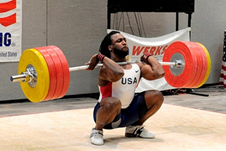 Front Squats are the best exercise that you can perform in conjunction with the deadlift to create a rock solid core and a ridiculous set of wheels. There is also the added benefit of targeting the spinal erectors and upper back.
Front Squats are the best exercise that you can perform in conjunction with the deadlift to create a rock solid core and a ridiculous set of wheels. There is also the added benefit of targeting the spinal erectors and upper back.
Front Squats are much easier on the body for two reasons: (1) You have to lighten the load and use less weight than a back squat and (2) They are almost impossible to do incorrectly.
The legs have to drive hard to move the weight while the back and abs have to work hard to stay erect to stop you from doubling over. That sounds a lot like a tackle, ruck, maul and scrum.
Technique
If you look at the above photo of USA lifter Kendrick Farris, he has achieved a rock bottom squat position with weight distributed evenly through his foot and with the bar resting on his deltoids.
In order to do this movement, you will need to have the bar resting on your fingertips between your front deltoids and neck. If the bar feels like it is trying to choke you a little bit, you are in the right position!
If you do not have the flexibility to achieve this position, use a cross armed grip as in the photo below. You should take note that all of the lifters in the images are sitting ‘down’ onto their heels rather than pushing their hips back to hit depth.
In order to achieve this break at the knee and hip simultaneously to initiate a repetition. As you begin to sink further down, allow your knees to track over your feet by pushing your knees out, by pushing your knees out it open up your hips and enables you to sit between your legs.
Once you’ve hit depth, drive your legs hard to come back up! And remember the bar is trying to pull you forward. To combat this, you need to actively arch your back and puff your chest out. Brace your abs by flexing them, take a large breath and hold it until you are near or at the top of the repetition.
Quantity
Like deadlifts, front squats should be done in lower reps, but they can be used both for low and high volume.
If you are looking to build size and strength, use more volume with a repetition scheme that puts your total working volume near 25 to 35 reps, such as 5×5, 6×4 or 10×3.
3. Incline Paused Bench Press
 The incline bench press is a new favourite of mine. The angle that you are pressing at is much closer to that of a tackle, or a hand off.
The incline bench press is a new favourite of mine. The angle that you are pressing at is much closer to that of a tackle, or a hand off.
Incline bench presses also generally take the leg drive out of the movement. By adding a pause on the chest it makes the movement even stricter by eliminating the chest bounce to lift more weight. The pause will also improve your ability to produce force by increasing your rate of force development.
The exercise also seems to be a little less stressful on the shoulders – whether it is from the lighter weight being used compared to the flat press, or the positioning/angle of the arm – it feels better for most.
Technique
This is another very simple exercise to perform. You want to have a fairly narrow grip – shoulder width or narrower is what I find works best.
Once you have gripped the bar, bring your chest up and your shoulders back and down. This is done by flaring the lats, pinching the shoulder blades together slightly and bracing the lower back. The chest should come up and out and the stomach in.
Place your feet out fairly wide and push your heels down into the floor, making sure your butt stays on the bench. When lowering the bar, imagine that you are bringing your chest up to meet the bar and pause on the chest for 2-5 seconds making sure that you stay tense throughout the abs, pecs, shoulders and triceps. Do this by bracing your abs and squeezing the bar as hard as you can.
When you press the bar, imagine that you are actually pressing your body into the bench rather than pressing the bar away. This will help you to keep a solid low back arch and keep your shoulder blades down and back.
Quantity
The Incline pause press should generally be done in moderate reps for moderate to high volume.
Five to ten reps is a good range to aim for with a total working volume of around 30 to 50 total reps.
4. Chinese Dumbbell Rows
Dumbbell Rows are a good exercise to develop the upper back and lat musculature, however by making a slight alteration you can turn this good accessory exercise into a great main exercise for the back, biceps, forearms and core stabilization.
The movement demands that you support your own bodyweight and remain rigid whilst pulling a weight from the floor into your body, which mirrors a ruck or tackle.
Technique
 This exercise is very simple to perform. Straddle a dumbbell, get a tight grip on the dumbbell, keep your back low and straight by bracing the abs, puff out the chest and pull the dumbbell into your body.
This exercise is very simple to perform. Straddle a dumbbell, get a tight grip on the dumbbell, keep your back low and straight by bracing the abs, puff out the chest and pull the dumbbell into your body.
If you wish to work more on your upper back (rhomboids, lower traps and rear delts) then pull the dumbbell in your sternum or chest.
For lat development, pull the dumbbell into your hip.
And for good all-around development, pull the dumbbell straight into your belly button.
Quantity
As long as you keep close to a 2:1 ratio between pulling and pushing movement reps, you will have much healthier shoulders.
You should do between 5 – 10 reps of this exercise.
Putting It All Together
You could get a lot out of these movements if all you did was hammer them hard twice per week.
One the first day, go with heavy weights and lower volume – aiming to develop your strength. On the second day, aim for moderate to high reps to create a stimulus for hypertrophy and aid in recovery.
If those two workouts were all you did for a season, you would not only easily maintain your strength, power and size to the end of the season, but it is very likely that you would increase it.
Please find two example workouts below that incorporate the four exercises and let me know if you have any questions or comments by commenting below.
Day 1
1. Front Squat
• 3 to 4 warm up sets
• 5×5, 5×3, 6×4, 2×5-4-3-2-1, or 3×3 reps with a heavy weight
2. Incline Pause Bench Press
• 3 to 4 warm up sets
• 5×5, 6×4, 2×5-4-3-2-1, or 3×3 with a heavy weight
3. Deadlift
• 3 to 4 warm up sets
• Heavy double, single, triple, 5×3, 5-4-3-2-1
4. Chinese Dumbbell Row • 3 to 4 warm up sets
• 6×5, 5×5, 3×8, 4×6, 2×5-4-3-2-1
Day 2
1. Front Squat
• 3 to 4 warm up sets
• 3-5 sets of 8 to 10 reps
2. Incline Bench Press
• 3 to 4 warm up sets
• 3-5 sets of 8 to 10 reps
3. Sumo Deadlift • 3 to 4 warm up sets
• 3-5 sets of 8 to 10 reps
4. Chinese Dumbbell Row
• 3 to 4 warm up sets
• 3-5 sets of 8 to 10 reps
Image References
The images used in this article were obtained from the following sites (images listed in order of appearance):
1. John Afoa from zimbio.com (http://www1.pictures.zimbio.com/gi/John+Afoa+New+Zealand+IRB+RWC+2011+Gym+Session+-6ygQ-oV_IGl.jpg)
2. Dan Green sumo deadlift from jtsstrength.com
3. Benedikt Magnusson Deadlift from http://www.brotherhoodofiron.com/articles/interview-with-benedikt-magnussonworld-record-deadlift-holder
4. Kendrick Farris Clean & Jerk recovery/front squat from games2010crossfit.com
5. Front Squat, clean grip and cross armed grip from stronglifts.com
6. Arnold Schwarzenegger Incline Bench Press from flexonline.com
7. Chinese Rows from http://strengthconditioning1.blogspot.co.uk/2010/08/dumbbell-row.html








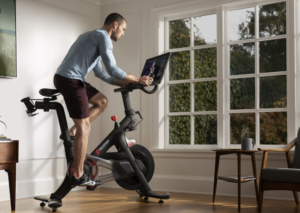 When most people hear the word “Peloton” they think of an expensive black bike with shiny red buttons and that controversial commercial where the husband gifted his wife a Peloton for Christmas.
When most people hear the word “Peloton” they think of an expensive black bike with shiny red buttons and that controversial commercial where the husband gifted his wife a Peloton for Christmas.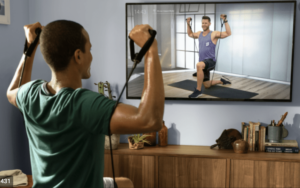 If the app interests you, Peloton is currently offering a 30 day FREE TRIAL, so why not give it a try? Check it out
If the app interests you, Peloton is currently offering a 30 day FREE TRIAL, so why not give it a try? Check it out 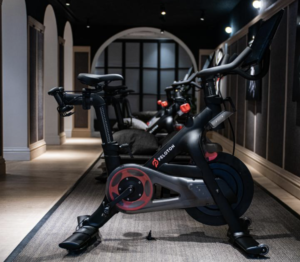
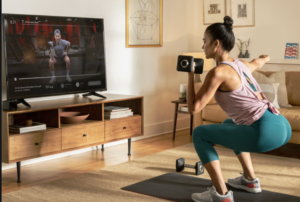
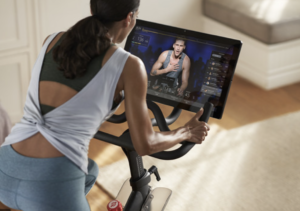 This article would not be complete, however, if we did not acknowledge some of the delivery issues that have been plaguing Peloton over the last year. Most of the delivery issues seem to affect U.S. deliveries, however, the UK deliveries have been affected as well.
This article would not be complete, however, if we did not acknowledge some of the delivery issues that have been plaguing Peloton over the last year. Most of the delivery issues seem to affect U.S. deliveries, however, the UK deliveries have been affected as well.








